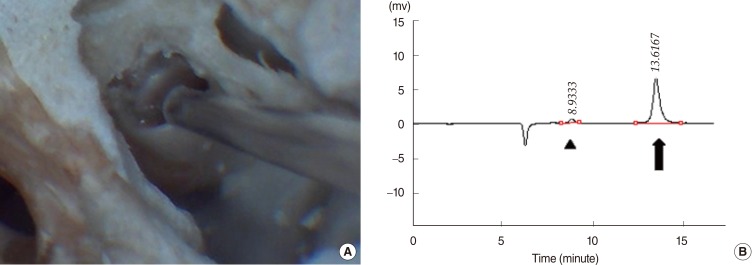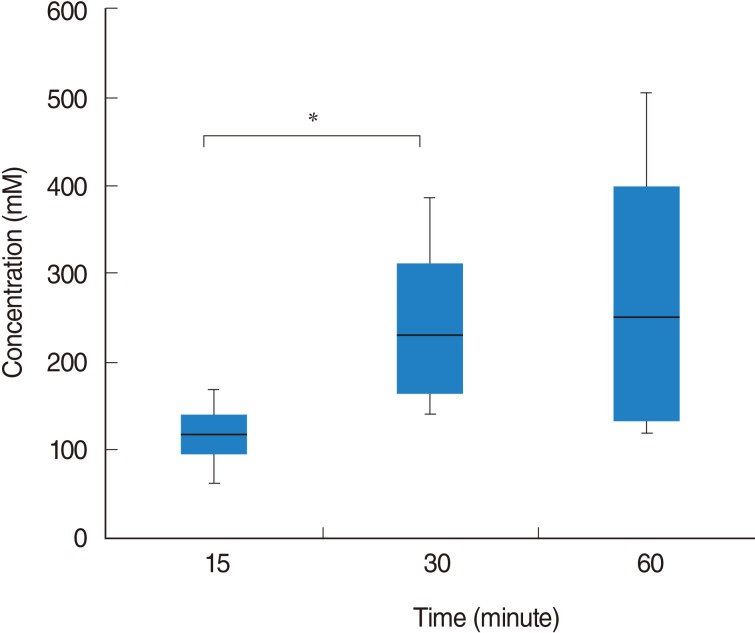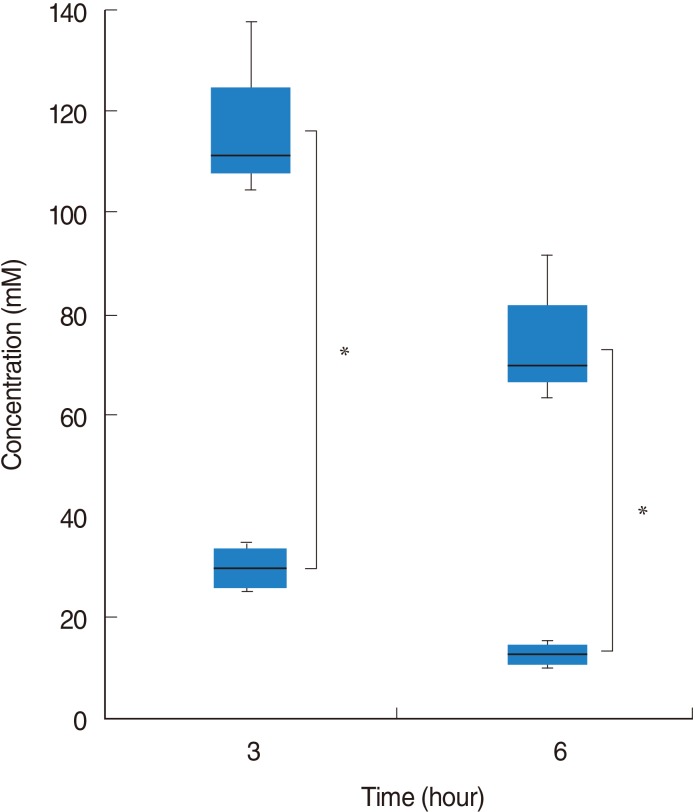Clin Exp Otorhinolaryngol.
2014 Dec;7(4):281-285. 10.3342/ceo.2014.7.4.281.
Isosorbide Concentration in Perilymph of the Guinea Pig After Oral Administration Versus That After Round Window Perfusion
- Affiliations
-
- 1Department of Otorhinolaryngology, Inha University College of Medicine, Incheon, Korea. stedman@inha.ac.kr
- KMID: 2278368
- DOI: http://doi.org/10.3342/ceo.2014.7.4.281
Abstract
OBJECTIVES
The aims of this study were to investigate the feasibility of isosorbide delivery into perilymph through the round window membrane (RWM), and to compare the intracochlear isosorbide concentration in perilymph after oral administration (PO) versus that after round window perfusion (RWP).
METHODS
Sixteen male guinea pigs (32 ears) were used. Isosorbide, an osmotic diuretic, was administered via RWP or PO. First, to investigate the optimal perfusion time, perilymph sampling of scala tympani from the RWM was performed after RWP for 15, 30, or 60 minutes. Second, to compare the drug concentration after RWP versus that after PO, perilymph was aspirated at 3 and 6 hours after administration. Intracochlear concentration of isosorbide was analyzed by high-performance liquid chromatography coupled to refractive index detection.
RESULTS
Isosorbide passed through the RWM into perilymph after RWP. After RWP for 15, 30, and 60 minutes, mean isosorbide concentrations in perilymph were 116.27+/-44.65, 245.48+/-112.84, and 279.78+/-186.32 mM, respectively. The intracochlear concentration after RWP for 30 minutes was higher than that after RWP for 15 minutes (P=0.043). At 3 and 6 hours after PO, isosorbide concentrations in perilymph were 28.88+/-4.69 and 12.67+/-2.28 mM, respectively. In contrast, the corresponding concentrations after RWP were 117.91+/-17.70 and 75.03+/-14.82 mM at 3 and 6 hours, respectively. Isosorbide concentrations in perilymph following RWP were significantly higher than those following PO at both 3 and 6 hours (P=0.025 and P=0.034, respectively).
CONCLUSION
Isosorbide can rapidly pass through the RWM after RWP in guinea pigs, and 30 minutes of perfusion is considered to be appropriate. In addition, over a 6-hour period, RWP can deliver higher concentrations of isosorbide into perilymph than those achieved with PO.
Keyword
MeSH Terms
Figure
Cited by 1 articles
-
Effects of Intratympanic Injection of Isosorbide on the Vestibular Function of Animal Models of Endolymphatic Hydrops
Minbum Kim, So Yeon Yoon, Hansol Hong, Hyun Jun Hong
Clin Exp Otorhinolaryngol. 2021;14(4):367-373. doi: 10.21053/ceo.2019.02040.
Reference
-
1. Kitahara M, Takeda T, Yazawa Y, Matsubara H, Kitano H. Treatment of Ménière's disease with isosorbide. ORL J Otorhinolaryngol Relat Spec. 1982; 44(4):232–238. PMID: 7110671.
Article2. Juhn SK, Prado S, Pearce J. Osmolality changes in perilymph after systemic administration of glycerin. Arch Otolaryngol. 1976; 11. 102(11):683–685. PMID: 985201.
Article3. Kakigi A, Takeda T, Saito H, Kataoka H. Effect of isosorbide on hearing loss due to endolymphatic hydrops. Acta Otolaryngol Suppl. 1995; 519:223–226. PMID: 7610874.
Article4. Takeda T, Takeuchi S, Saito H. Effect of glycerol on pressure differences between perilymph and endolymph. Acta Otolaryngol. 1990; Jul-Aug. 110(1-2):68–72. PMID: 2386035.5. Kakigi A, Takeda S, Takeda T, Sawada S, Azuma H, Higashiyama K, et al. Time course of dehydrating effects of isosorbide on experimentally induced endolymphatic hydrops in guinea pigs. ORL J Otorhinolaryngol Relat Spec. 2004; 66(6):291–296. PMID: 15668526.
Article6. Klockhoff I. Diagnosis of Menière's disease. Arch Otorhinolaryngol. 1976; 9. 212(4):309–314. PMID: 990081.
Article7. Padoan S. Oral versus i.v. administration of the glycerol test: side-effects and usefulness. Acta Otolaryngol. 2003; 5. 123(4):482–487. PMID: 12797582.
Article8. Matsubara H, Kitahara M, Takeda T, Yazawa Y. Rebound phenomenon in glycerol test. Acta Otolaryngol Suppl. 1984; 419:115–122. PMID: 6599220.
Article9. Larsen HC, Angelborg C, Klockoff I, Stahle J. The effect of isosorbide and urea on hearing inpatients with Ménière's disease. Acta Otolaryngol (Stockh) Suppl. 1984; 412:113–114.10. Yamazaki T, Imoto T, Hayashi N, Watanabe S, Kozaki H, Abe T. Menière's disease and isosorbide as an oral hyperosmotic agent. Arch Otorhinolaryngol. 1982; 234(1):97–104. PMID: 7082223.11. Nozawa I, Nakayama H, Hashimoto K, Imamura S, Hisamatu K, Murakami Y. Efficacy of long-term administration of isosorbide for Ménière's disease. ORL J Otorhinolaryngol Relat Spec. 1995; May-Jun. 57(3):135–140. PMID: 7603692.
Article12. Kakigi A, Takeda T, Sawada S, Taguchi D. Antidiuretic hormone and osmolality in isosorbide therapy and glycerol test. ORL J Otorhinolaryngol Relat Spec. 2006; 68(5):279–282. PMID: 16699291.
Article13. Scheibe F, Haupt H. Biochemical differences between perilymph, cerebrospinal fluid and blood plasma in the guinea pig. Hear Res. 1985; 1. 17(1):61–66. PMID: 3997682.
Article14. Sajjadi H, Paparella MM. Meniere's disease. Lancet. 2008; 8. 372(9636):406–414. PMID: 18675691.
Article15. Goycoolea MV, Lundman L. Round window membrane. Structure function and permeability: a review. Microsc Res Tech. 1997; 2. 36(3):201–211. PMID: 9080410.
Article16. Salt AN, Kellner C, Hale S. Contamination of perilymph sampled from the basal cochlear turn with cerebrospinal fluid. Hear Res. 2003; 8. 182(1-2):24–33. PMID: 12948598.
Article
- Full Text Links
- Actions
-
Cited
- CITED
-
- Close
- Share
- Similar articles
-
- Auditory Effects of Microperfused Lidocaine on Guinea Pig Cochlea
- A study on catecholamine concentrations in the perilymph and the CSF of normal guinea pig
- Effect of IL-1beta on Hearing and Penetration through Round Window Membrane in Guinea Pig
- The Change of Hearing Threshold and Perilymphatic Lactate Concentration in Guinea Pigs with Induced Hypoxia
- Effects of Intratympanic Injection of Isosorbide on the Vestibular Function of Animal Models of Endolymphatic Hydrops




